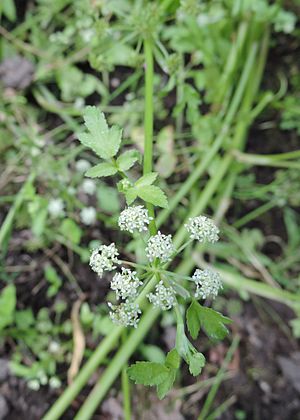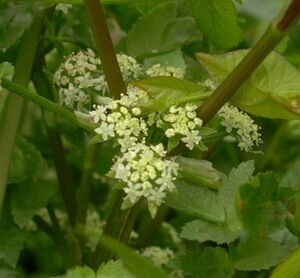Fool's-watercress facts for kids
Quick facts for kids Fool's-watercress |
|
|---|---|
 |
|
| Conservation status | |
| Scientific classification | |
| Genus: |
Helosciadium
|
| Species: |
nodiflorum
|
Helosciadium nodiflorum, also known as fool's watercress, is a type of flowering plant. You can find it growing in wet places like ditches, streams, and wetlands. It is native to western Europe. This plant is not harmful to humans if eaten. However, it can sometimes be mistaken for another plant called lesser water parsnip, which is said to be poisonous.
What it Looks Like
Fool's watercress is a plant that grows low to the ground. It can reach up to 1 meter (about 3 feet) tall. It doesn't have hairs on its stem or leaves. Its stem is hollow and has faint ridges. When the stem lies down, it can grow roots from its joints, called nodes.
The leaves are shiny and look like feathers, with smaller leaflets arranged along a central stem. Each leaf has about 4 to 6 pairs of leaflets. These leaflets are oval to spear-shaped and have small teeth along their edges. The underside of the leaflets is a slightly lighter green. You might notice ring-like ridges at the joints of the leaflets. This is a key difference from the lesser water-parsnip, which has a ring on its leaf stalk.
The leaf stalks are hollow and have a single groove on top. They might have red or purple lines. Near the base, they widen and wrap around the main stem. If you crush the leaves, they smell like carrots!
Plant Names and History
For a long time, this plant was known as Apium nodiflorum. But in 2010, scientists studied the Apium group of plants more closely. They found that the group needed to be split into different smaller groups. Because of this, five European species, including Apium nodiflorum, were moved to a new group called Helosciadium.
This change actually brought the plant back to a name first suggested by a scientist named Wilhelm Daniel Joseph Koch in 1824. So, the correct scientific name for this plant today is Helosciadium nodiflorum W.D.J. Koch.
Where it Grows
Fool's watercress is very common in England, Wales, and Ireland. However, it is not as common in Scotland. It loves wet places and often grows alongside watercress.
You can find it in many watery habitats. These include ditches, natural springs, fens (a type of wetland), and ponds. It also grows well in areas where fresh water mixes with salty water, like river mouths and salt marshes. This plant usually blooms in July and August.
How People Use It
In some countries around the Mediterranean Sea, like Spain, Italy, Portugal, and Morocco, people have traditionally gathered and eaten wild fool's watercress.
The young leaves and tender shoots of the plant are edible. People can eat them raw in salads. They can also be boiled or used to add flavor to soups and other dishes.
See also
 In Spanish: Apium nodiflorum para niños
In Spanish: Apium nodiflorum para niños



